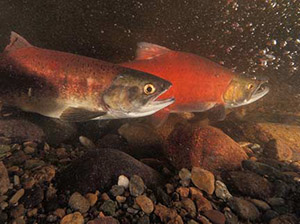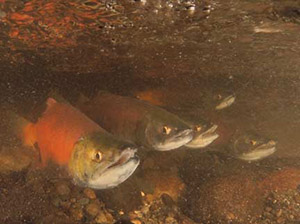Lake Sammamish kokanee
Recovering a native species

A male (background) and female (foreground) kokanee pair up to spawn in Ebright Creek.
Kokanee (pronounced kō ́ ka nē) salmon are native to the Lake Sammamish and Lake Washington watershed. Unlike their larger relative the sockeye salmon, kokanee do not go out to the ocean. They migrate from streams as inch-long fry and spend three to four years in lakes. Then they return to spawn in the streams where they were born.

Lake Sammamish kokanee in Ebright Creek, Sammamish.
Historically, kokanee were plentiful throughout the Lake Washington and Lake Sammamish watershed. Today their known range is only Lake Sammamish and a few of its tributary streams used for spawning in late fall and early winter. While new research suggests native kokanee likely persist in Lake Washington, the Sammamish River, and tributaries to the Sammamish River, too, this research is ongoing and remains uncertain.
The Lake Sammamish kokanee once numbered in the tens of thousands of fish. But since 2007-2008, the number of returning spawners has dipped below 150 fish eight times, and the risk of extinction remains high. Several factors contribute to this decline, including:
- Altered stormwater flows
- Past hatchery practices
- Predation
- Fishing
- Passage barriers
- Lake temperature and dissolved oxygen levels

A pair of kokanee in Ebright Creek.
The Lake Sammamish Kokanee Work Group (KWG) is driving the collaborative effort to recover these little red fish. The KWG formed in 2007 as a coalition of:
- Watershed residents
- Local jurisdictions and tribes
- Local, state, and federal agencies
- Nonprofit organizations
Together they work to identify the causes of kokanee decline and then develop and implement actions to address them.
Learn more about the goals and accomplishments of the Kokanee Work Group
Photos by Roger Tabor, USFWS

 Translate
Translate